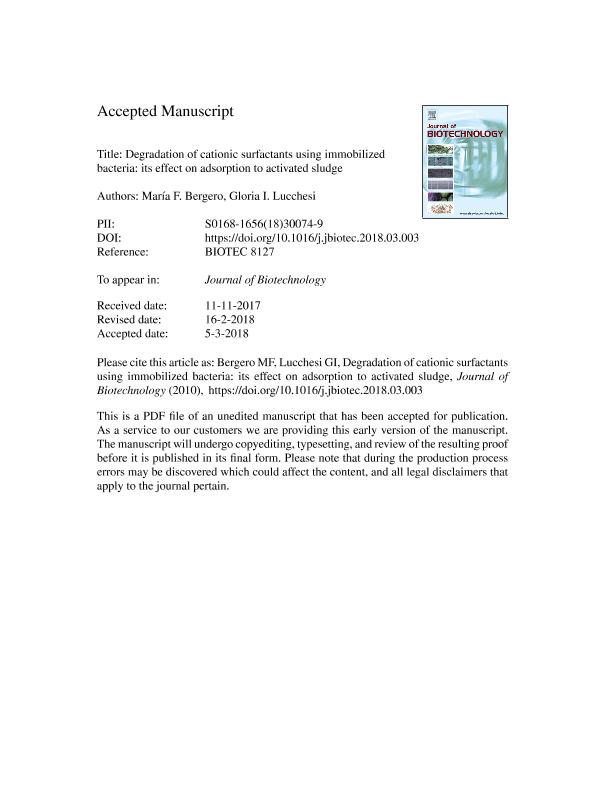Mostrar el registro sencillo del ítem
dc.contributor.author
Bergero, Maria Fernanda

dc.contributor.author
Lucchesi, Gloria Ines

dc.date.available
2021-08-27T19:08:01Z
dc.date.issued
2018-04-20
dc.identifier.citation
Bergero, Maria Fernanda; Lucchesi, Gloria Ines; Degradation of cationic surfactants using immobilized bacteria: Its effect on adsorption to activated sludge; Elsevier Science; Journal of Biotechnology; 272-273; 20-4-2018; 1-6
dc.identifier.issn
0168-1656
dc.identifier.uri
http://hdl.handle.net/11336/139138
dc.description.abstract
Adsorption of cationic surfactants (QACs) Br-tetradecyltrimethylammonium (TTAB), Cl-tetradecylbenzyldimethylammonium (C14BDMA) and Cl-hexadecylbenzyldimethylammonium (C16BDMA) to activated sludge from a wastewater treatment plant was tested. Adsorption equilibrium was reached after 2 h, and for initial 200 mg L−1 81%, 90% and 98% of TTAB, C14BDMA and C16BDMA were respectively adsorbed. After six successive desorption cycles, 21% of TTAB and 12.7% of C14BDMA were desorbed from the sludge. In agreement with the percentage of QACs pre-adsorbed, the more hydrophobic the compound, the lesser the extent of desorption. Wastewater samples with activated sludge were supplemented with TTAB 200 mg L−1 and Ca-alginate beads containing the QACs-degrading microorganisms Pseudomonas putida A (ATCC 12633) and Aeromonas hydrophila MFB03. After 24 h, 10 mg L−1 of TTAB were detected in the liquid phase and 6–8 mg L−1 adsorbed to the sludge. Since without Ca-alginate beads or with empty beads total TTAB amount (phase solid and liquid) did not change, the 90% reduction of the initial 200 mg L−1 after treatment with immobilized cells was attributed to the bacterial consortium's capacity to biodegrade QACs. The results show the advantages of using immobilized bacteria to achieve complete QACs elimination from wastewater systems, thus preventing them from reaching the environment.
dc.format
application/pdf
dc.language.iso
eng
dc.publisher
Elsevier Science

dc.rights
info:eu-repo/semantics/openAccess
dc.rights.uri
https://creativecommons.org/licenses/by-nc-nd/2.5/ar/
dc.subject
ACTIVATED SLUDGE
dc.subject
ADSORPTION
dc.subject
BIODEGRADATION
dc.subject
CATIONIC SURFACTANTS
dc.subject.classification
Otras Biotecnología del Medio Ambiente

dc.subject.classification
Biotecnología del Medio Ambiente

dc.subject.classification
INGENIERÍAS Y TECNOLOGÍAS

dc.title
Degradation of cationic surfactants using immobilized bacteria: Its effect on adsorption to activated sludge
dc.type
info:eu-repo/semantics/article
dc.type
info:ar-repo/semantics/artículo
dc.type
info:eu-repo/semantics/publishedVersion
dc.date.updated
2021-08-13T16:27:23Z
dc.identifier.eissn
1873-4863
dc.journal.volume
272-273
dc.journal.pagination
1-6
dc.journal.pais
Países Bajos

dc.journal.ciudad
Amsterdam
dc.description.fil
Fil: Bergero, Maria Fernanda. Universidad Nacional de Río Cuarto. Facultad de Ciencias Exactas Fisicoquímicas y Naturales. Departamento de Biología Molecular; Argentina. Consejo Nacional de Investigaciones Científicas y Técnicas. Centro Científico Tecnológico Conicet - Córdoba; Argentina
dc.description.fil
Fil: Lucchesi, Gloria Ines. Universidad Nacional de Río Cuarto. Facultad de Ciencias Exactas Fisicoquímicas y Naturales. Departamento de Biología Molecular; Argentina. Consejo Nacional de Investigaciones Científicas y Técnicas. Centro Científico Tecnológico Conicet - Córdoba; Argentina
dc.journal.title
Journal of Biotechnology

dc.relation.alternativeid
info:eu-repo/semantics/altIdentifier/url/https://www.sciencedirect.com/science/article/pii/S0168165618300749
dc.relation.alternativeid
info:eu-repo/semantics/altIdentifier/doi/https://doi.org/10.1016/j.jbiotec.2018.03.003
Archivos asociados
